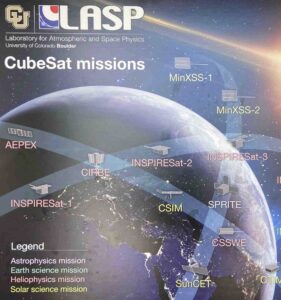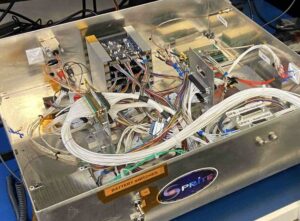My name is Liam Intemann, and I am grateful to have been able to intern at the Laboratory for Atmospheric and Space Physics (LASP) this summer. I am mentoring under Dmitry Vorobiev, focusing on various aspects of astrophysics and space technology. LASP has many interns, including another Pintern, Patrick Minnehan. On average, my day will be from 9:30-10:00 am to 5:00 pm. As an introduction, this week has been highly informative, from the in-depth discussions, tours, experiments, and lessons from experts.
Starting, we observed the testing of a component for LASP’s current project, a CUBESat (made to conduct space research and technology demonstrations in a cost-effective and compact form) named SPRITE (Supernova Remnants and Proxies for Reionization Testbed Experiment.) (Image One and Two) The component that was being tested was an antenna; this antenna was placed inside an anechoic chamber, a room designed to completely absorb reflections of sound or electromagnetic waves, creating an environment free from external noise and echo, simulating space. This was done to ensure accurate measurements of its function. Towards the afternoon, I completed the necessary training to be qualified to work in the lab: Cleanroom, Hazmat, and ESD training. For the following days, along with Patrick Minnehan, we mainly worked on an experiment to observe UV light through a glass fiber, which would be the world’s first. This procedure is done by aligning the fiber inside a vacuum, which is necessary to eliminate atmospheric interference to see the full spectrum of UV light—and then aligning the microscope to observe the UV light. The following process involves turning off all lights to allow the instruments to detect UV light accurately. That is as far as we got this week, and hopefully, next week, the experiment will result in success. A highlight from my first week was our discussion about star formations and the ionization of radiation. The meeting was in response to an article discussing the methods of detecting star formation. In short, we discussed how molecular clouds collapse under gravity to form stars and how ultraviolet radiation from these young stars ionizes the surrounding gas. This is important in identifying the areas of active star formation in various galaxies. In the end, we concluded that accurately detecting star formation is challenging, and being confident about the findings is hard.
Aside from my internship, I have been going to the CU Boulder’s rec center daily, going to the gym, climbing, and swimming. I am staying at a house host with an incredible host family and Patrick, allowing us to work together and explore Boulder outside of our internship. Overall, it has been a great experience, and I look forward to more adventures and learning opportunities in the coming weeks!



Liam, that’s incredible. I hope you continue to enjoy and learn from this amazing experience, making new connects, friends, and exploring fun activities! ❤️